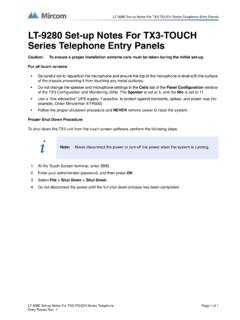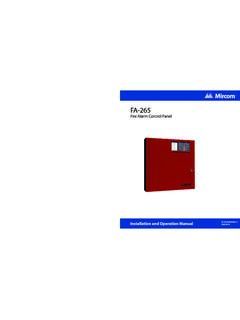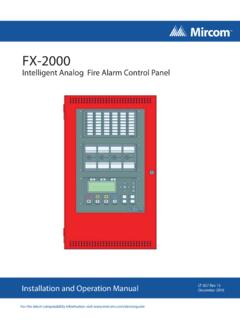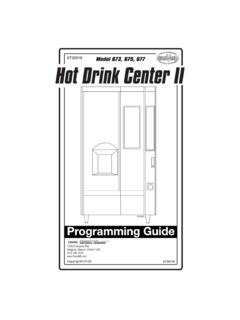Transcription of FA-1025T - Mircom
1 FA-1025 TFir e Alarm Contr ol PanelLT-493 Rev. 2012 Installation and Operation ManualAdvanced Life Safety ONSIGNALSILENCED54321FA-1025T Fire Alarm Control PaneliContentsList of iiIntroduction .. 1 Mechanical Installation .. 1 Function Selection .. 1 Wiring .. 2 Detection Zones .. 2 Signal Zone .. 2 Alarm and Trouble 2 Remote Power and 3 Trouble Indicators and 3 Common Trouble LED .. 3 Buzzer/Buzzer Silence Switch .. 3 Zone Trouble 3 Battery Fault 3 Ground Fault LED .. 3 Remote Lamp Fail 3 Signal Trouble LED .. 3 Sequence of 4 Signal silence .. 4 Reset/Lamp 4 System Checkout .. 4 Power up and Troubleshooting .. 4 Wiring Tables and 8 Appendix A: Compatible Devices .. 10 Underwriter s Laboratories Canada (ULC) Canadian 2-Wire Smoke Detector Control 10 Underwriter s Labs Inc. (ULI) United States 2-Wire Smoke Detector Control Panel Compatibility .. 11 Underwriter s Labs Inc.
2 (ULI) United States Signaling Device Control Panel Compatibility. 13 Appendix B: Battery Calculations (Selection Guide).. 15 List of FiguresiiList of FiguresFigure 1: Backbox and flush trim mounting details .. 5 Figure 2: Circuit Board Layout .. 6 Figure 3: Detection and signal 7 Figure 4: Wiring table for detection zone .. 8 Figure 5: Wiring table for bells and horns .. 8 Figure 6: Alarm and trouble relay contacts and remote annunciation wiring instructions .. 9FA-1025T Installation and Operation Manual1 IntroductionThe FA-1025T is a supervised five-zone 24 VDC Fire Alarm Control Panel. The panel is ULC listed and meets all performance and operational requirements of ULC. The FA-1025T provides the following features: Five Class B detection zones Two Class B signal zone, DIP switch selectable signal circuit outputs such as Temporal or Steady Alarm and trouble relay contacts Remote trouble and AC On indication Remote supervised alarm annunciation Individual zone silence/disconnect switch Buzzer silence switch Subsequent alarm operation LED indicators for zone alarm and trouble, On, Battery Fault, Ground Fault, Common Trouble, Signal Trouble and Signal SilencedMechanical InstallationThe panel can be surface or flush mounted.
3 Refer to Figure 1 on page 5 for Mounting1. Mark the location of the four mounting holes. 2. Install the top two screws into the wall and place the panel over the screws. 3. Install the bottom screws and tighten down all four Mounting1. Make the wall cut-out according to the panel dimensions. 2. Remove the control panel door. 3. Mount the flush mounting trim (model FA-102TR) to the back box using the screws and nuts provided with the flush mounting kit. 4. Re-install the door on top of the flush trim. The cam lock may require a minor adjustment in order to compensate for the flush SelectionThe following jumpers are available for function selection. Refer to Figure 2 on page 6 for location. JW1: Cut for resettable +24V DC supply. JW2: Cut to make auxiliary relay disconnectable. JW3: Cut for normally open trouble contacts. JW4: Cut for normally closed trouble contacts. JW5: Cut for non-latching alarm zone 4. JW6: Cut for non-latching alarm zone JW7: Cut to enable supervision of remote annunciation alarm zone switch DSW1 is used to set the preferred signal zone outputs, the signal silence inhibit, and the common trouble flash rate.
4 Temporal Code: 3 rounds of second ON, second OFF, then second pause. Steady: Signal on ZonesThe system has five detection zones. Refer to Figure 3 on page 7 for wiring instruction and to Figure 4 on page 8 for wire ZoneThere are two signal zones available for bells and horns providing of signal power. Refer to Figure 3 on page 7 for wiring instruction and to Figure 5 page 8 on for wire and Trouble RelaysAlarm and trouble relay contacts are provided. Refer to Figure 6 on page 9 for contact location and : Any time the DIP switches in DSW1 are positioned (ON or OFF), the panel must be reset by holding the Reset button for 5 usedTrouble Buzzer and LEDON - steady buzzer and LEDOFF - Pulsing Buzzer and LED (default)Signal Zone 2ON - steadyOFF - temporal code (default)ON - 1 minute signal silence inhibitOFF - normal signal silence (default)Signal Zone 1ON - steadyOFF - temporal code (default)DIP switch DSW1FA-1025T Installation and Operation Manual3 Remote AnnunciationAnnunciation outputs are provided for alarm, remote trouble indicator and buzzer.
5 Cut JW7 to enable lamp supervision for the remote annunciator alarm zones. Refer to Figure 6 on page 9 for wiring Power and BatteriesThe power is connected to the terminal block above the Gel Cell or Sealed Lead-Acid type of batteries only. Connect the batteries after power up. Use 24V 4AH batteries for 24 hours standby and 5 or 30 minutes of alarm. For greater accuracy, use the battery calculations chart located in Appendix B on page RATING: 120V, 60Hz, 1A / 240V, 50Hz, Indicators and ControlsRefer to Figure 2 on page 6 for the location of indicators and Trouble LEDThe yellow Common Trouble LED will flash and the buzzer will sound for any trouble in the panel (unless DSW1-8 is ON, then the common trouble LED will illuminate steadily and the buzzer will sound).Buzzer/Buzzer Silence SwitchThe buzzer will sound intermittently for any trouble. The buzzer will sound steadily for any alarm in the system. Operating the Buzzer Silence switch will silence the buzzer.
6 Any subsequent alarm will resound the buzzer. Turning the Buzzer Silence switch OFF normal will sound the buzzer Trouble LEDThe yellow Zone Trouble LED will illuminate steadily for an open loop in the zone wiring. Refer to Figure 2 on page 6 for the location of indicators and Fault LEDB attery removal, low voltage and open battery leads will turn on the yellow Battery Fault LED and the Common Trouble Fault LEDAny ground fault of 10K ohms or less will turn on the yellow Ground Fault LED steadily, flashing the Common Trouble LED and sounding the common trouble buzzer Lamp Fail LEDAny open on the supervised remote annunciator wiring will illuminate the yellow Remote Lamp Fail LED steadily, flash the Common Trouble LED and the Common Trouble buzzer will sound Trouble LEDThe yellow Signal Trouble LED will illuminate steadily for any open or short. (The LED is located behind the display plate.)Sequence of Operation4 Sequence of OperationRefer to Figure 2 on page 6 for the location of indicators and indicators are normally OFF except for the green On red zone alarm LED will illuminate steadily for incoming silenceIf the 60 second signal silence inhibit is selected, the signal cannot be silenced for 60 seconds after an alarm initiation.
7 Once the 60 seconds have expired, pushing the signal silence switch to the right will silence all the bells and horns. Once the signal has been silenced, the signal silenced LED will illuminate. If the switch is in the OFF normal position to the right while there is no alarm condition, the panel will indicate TestOperating the reset switch will restore all latched functions in the panel. The smoke detectors will reset if all products of combustion are cleared from their chambers. Holding the reset switch for five seconds will cause the panel to preform a lamp test as well as reset the CheckoutBefore turning the power on,1. Check all external wiring for opens, shorts or Check that transformer cables are securely Check the power wiring for proper connection. To prevent sparking, do not connect Check that all switches are in the normal position to the up and Troubleshooting1. After completing all of the system checkout procedures, power up the panel.
8 The On LED should trouble buzzer should sound intermittently, and the Common Trouble LED should flash, indicating battery Connect the batteries carefully, observing the correct Common Trouble LED should extinguish. If the Common Trouble LED stays on, check the front panel for the illumination of the following LEDs: Battery LED indicates that the battery voltage may be too low (below ). Ground Fault LED indicates a ground on one or more of the extended wires. Zone Trouble LED indicates an open loop or a signal silence switch is in the OFF normal position to the right. Signal Trouble LED indicates an open loop or short in the signal 1: Backbox and flush trim mounting details13 3/4 12 3/4 111/16 Optional flush mounting trim (model FA-102TR)Four 7/32 dia. mounting holes27/8 71/8 11/4 10 3/8 6 Figure 2: Circuit Board LayoutALARM RELAYNO C + 12 + - + - 1+ -TB2 2+ - 3+ - 4+ - 5+ - COM (-)TB1Z1 Z2 Z3 Z4 3 ZONE 4 ZONE + ZONESBUZZER 1 DIP SWITCHES18 SIGNALZONE 2 3 4 5 Installation and Operation Manual7 Figure 3: Detection and signal wiringLegendPull StationSmokeDetectorHeatDetectorBellFFSR A larm threshold current is 21 loop resistance is 100 zone zone 1 Detection zone 2+-+-22 VDC 3mA STBY5mV ripple50 mA max.
9 Alarm22 VDC 3mA STBY5mV ripple50 mA max. alarm24 VDC +-+-+-+-Detection zone 322 VDC 3mA STBY5mV ripple50 mA max. zone 422 VDC 3mA STBY5mV ripple50 mA max. zone 522 VDC 3mA STBY5mV ripple50 mA max. zone 224 VDC max.+-FFWiring Tables and Information8 Wiring Tables and InformationFigure 4: Wiring table for detection zoneFigure 5: Wiring table for bells and hornsSignal circuits are rated for amperes GaugeMaximum Wiring Run to Last Device (ELR)(AWG) : Maximum loop resistance should not exceed 100 Signal LoadMaximum Wiring Run to Last Device (ELR)Max Loop : Maximum voltage drop should not exceed Installation and Operation Manual9 Figure 6: Alarm and trouble relay contacts and remote annunciation wiring instructionsAuxiliary common alarm relay contacts 28 VDC, 3A (resistive)Common trouble relay contacts 28 VDC, 3A (resistive)Cut JW3 for JW4 for ON50 mA , 50 mA , 50 mA troubleLED (amber)buzzerLED (green)remote troubleCut JW7 to enable lamp supervision for the remote annunciator alarm zones.
10 If LEDs are supervised, jumper to the unused out-puts to common (+) with a series ONcommon (+) 24 VDC, 250mA etomer1 enoz 1 Zremote alarmLED (red)LED (red) zone 2Z3 zone 3Z4 zone 4Z5 zone alarmLED (red)remote alarmLED (red)remote alarmLED (red)Appendix A: Compatible Devices10 Appendix A: Compatible DevicesUnderwriter s Laboratories Canada (ULC) Canadian 2-Wire Smoke Detector Control PanelNotes: Reset time, hold for five seconds minimum. Whether mixing different models of compatible smoke detectors, or using the same model on the same Circuit, total standby current of all detectors must not exceed 3 Model / BaseMake Model / BaseMake Model / BaseMircomCerebrus PyrotronicsFenwalMIR-525D1-2 PSD-7131/70-201000-001 MIR-525TD1-3/DB-3 SPSD-7131/70-201000-002 System SensorPSD-7131/70-201000-0031400-APSD-71 31/70-201000-0052400-AMirtonePSD-7130/70 -201000-0011451-A/B401B73471 PSD-7130/70-201000-0021451-A/B406B73494 PSD-7130/70-201000-0032451-A/B401B73575 PSD-7130/70-201000-0052451-A/B406B73495/ 73486 PSD-7128/70-201000-0011451DH/DH400A73495 /73487 PSD-7126/70-201000-0022451-A/DH400A73595 /73486 PSD-7126/70-201000-003C2W-BA73595/73497 PSD-7126/70-201000-005C2WT-BA73594/73400 PSD-7129/70-201000-000 Edwards73405/73400 PSD-7125/70-201000-0016249C73594/73401 PSD-7126/70-201000-0026250C73405/73401 PSD-7125/70-201000-0036264 CPSD-7125/70-201000-0056266 CCPD-7021/70-201000-0016269 CSimplexCPD-7021/70-201000-0026270C2098- 9110 CPD-7021/70-201000-0036269C-003












